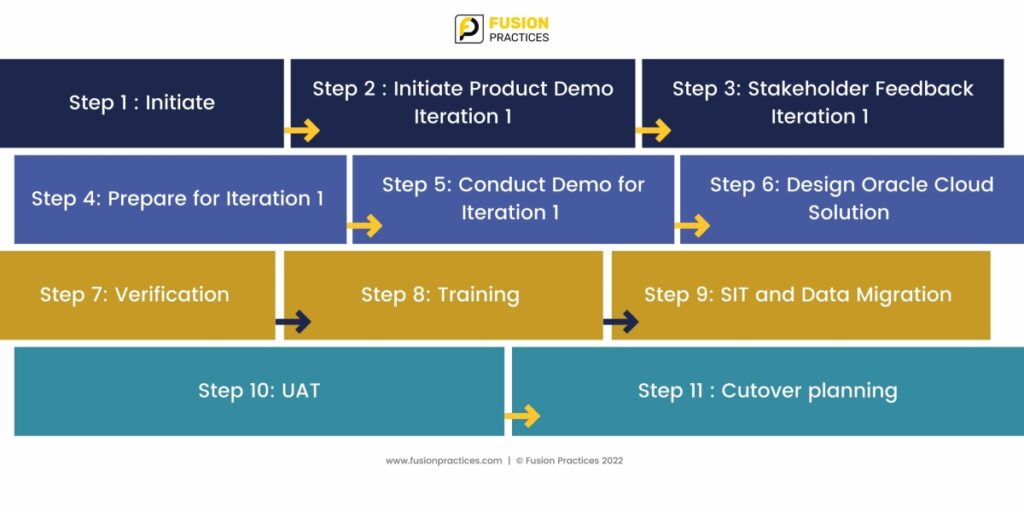Implementing Oracle Cloud ERP can prove to be a cumbersome process if it is not strategically divided and actioned upon. We recommend setting an entry and exit criteria which will help in determining whether the software implementation is in the right track and the entire team can focus on the tasks and conditions set for the stage. This enhances the effectiveness & efficiency of the implementation team to a greater extent, as the common goal to reach exit criteria of the stage is predefined. In simple words, entry criteria define the prerequisite requirements that must be completed during each phase of project implementation while the exit criteria defines the items/documents/actions/tasks that must be completed before concluding the current phase and moving on to the next phase.

The steps below set out detailed steps that Fusion Practices follows along with its entry and exit criteria.
Step 1 : Initiate
Entry Criteria:
- Signing of SOW
- Provisioning of Environment
Exit Criteria:
- Baseline of Project plan
- Setting up Initial RAID log
- Signing requirement’s traceability matrix template
- Completion of environment strategy document
- Approval of project status report template
- Agreement of Communication plan
Step 2 : Initiate Product Demo Iteration 1
Entry Criteria:
- Check point to start Oracle Cloud ERP map- Product Demonstration 1
- Alignment of stakeholders and setting up of required meetings
Exit Criteria:
- Completion of Configuration questionnaire
- Agreement of Data migration strategy
Step 3: Stakeholder Feedback Iteration 1
Entry Criteria:
- Check points determined to start Product Demonstration-1 design phase
- Alignment of Stakeholders and setting up required meetings
- Listing of Product Demonstration-1 scenarios
Exit Criteria:
- Organising technical workshops
- Completion of foundation design document
- Drafting configuration workbook
- Drafting solution design document
- Making application architecture diagram
Step 4: Prepare for Iteration 1
Entry Criteria:
- Check point to start Product Demonstration-1 build phase
- Alignment of Stakeholders and setting up required meetings
Exit Criteria:
- Technical design documents for each integration and extensions/customisations
- Configuring system for Product Demonstration-1
- Data migration extract scripts
- Data migration verification reports
- Integrations – Product Demonstration 1
- Extension/customisations – Product Demonstration 1
Step 5: Conduct Demo for Iteration 1
Entry Criteria:
- Conducting Product Demonstration-1 demo sessions
- Aligning Stakeholders and scheduling diaries
Exit Criteria:
- Completion of Demo sessions
- Updating requirement’s traceability matrix
Step 6: Design Oracle Cloud Solution
Entry Criteria:
- Check point to start Product Demonstration-2 design phase
- Alignment of Stakeholders and setting up required meetings
- Listing of Product Demonstration-2 scenarios
Exit Criteria:
- Signing of Solution design document
- Signing of configuration workbook
- Drafting cutover plan
Step 7: Verification
Entry Criteria:
- Check point to start Product Demonstration-1 build phase
- Alignment of Stakeholders and setting up required meetings
Exit Criteria:
- Technical design documents for technical components
- Conducting second demonstration of system
- Migration verification reports
- Making a list of data cleansing requirements
- Integrations – Product Demonstration 2
- Extension/customisations – Product Demonstration 2
- Drafting training material
Step 8: Training
Entry Criteria:
- Organising Product Demonstration-2 demo sessions
- Stakeholders aligned and diaries scheduled
Exit Criteria:
- Scheduling final batch job
- Training sessions scheduled
- Writing and approval of Test scripts
Step 9: SIT and Data Migration
Entry Criteria:
- Oracle instance ready for SIT
- Publishing of SIT data migration verification reports
Exit Criteria:
- Completion of System integration testing
- Addressing issues listed with mitigation plan
Step 10: UAT
Entry Criteria:
- Oracle instance ready for UAT
- UAT data migration verification reports
- Customer business ready for UAT
Exit Criteria:
- User acceptance testing complete with UAT evidenced and test outcome for each script
- Addressing issues listed with mitigation plan
- Signing off Configuration workbook
- Signing off cutover plan
- Go live checklist agreed
Step 11 : Cutover planning
Entry Criteria:
- Oracle instance ready for go live
- Data migration verification reports to confirm status of data migration
- Deployment checklist
- Check point to agree go-live ready
- Submit change control
- Granting permission from the customer to deploy to live environment
Exit Criteria:
- Transition plan agreed
- System deployment
- Smoke testing
- Go / no-go decision
- Completing documents and storing them for customer’s access
- Post project review held
These laid out steps ensure that at every stage, there is clarity on the process that Fusion Practices follows in order to implement Oracle Cloud ERP. These entry and exit criteria work as checkpoints for the customer to know where they are situated in the process.


